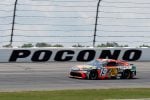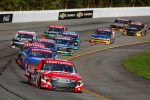What Happened?
Chase Briscoe was able to stretch his fuel the distance at Pocono Raceway, leading 72 of the race’s 160 laps to win Sunday’s (June 22) Great American Getaway 400.
On his final pit stop, Briscoe left the pit box earlier than crew chief James Small wanted him to, creating a situation where Briscoe was in constant fuel saving mode for the remainder of the race. The fuel lasted, and Briscoe picked up his first career win with Joe Gibbs Racing.
Denny Hamlin, in his return after missing Autodromos Hermanos Rodriguez, finished second, followed by Ryan Blaney in third. Chris Buescher and Chase Elliott finished fourth and fifth, respectively.
What Really Happened?
Dirty air strikes again.
Ugh.
The Next Gen car’s ability to pass (or lack thereof) is no secret at this point as its fourth season in use progresses. That’s why it’s so frustrating that we are continually having these discussions of dirty air ruining the racing at tracks like Pocono, where there should be incredible racing for more than just two laps after a restart.
Let’s get one thing straight right off the bat: All the credit in the world to Briscoe for saving fuel for almost 40 laps around a 2.5-mile track. The team was clearly panicked when he left the pit box early, and it was a monumental feat to save fuel from the lead for the entire final run.
But let’s be 100% honest with ourselves. For as much fuel as the No. 19 had to save, there is no way in any sensible form of racing that the leader can ever save as much fuel as Briscoe did, and do it comfortably. Second-place Hamlin, the polesitter and leader for 32 laps on the day, couldn’t even mount a challenge against his teammate because dirty air prevented him from doing so.
And that’s with Briscoe spending considerably more time out of the throttle than the No. 11, who was good to go to the end on fuel.
The worst part is that this is beating a dead horse. There have been way too many conversations about how dirty air affects the racing in the Next Gen, and that all the leader has to do to maintain the lead is aero block and cause the driver behind him to lose all momentum.
It’s common sense that if you’re running slower than someone behind you, there’s a high probability you ought to get passed, right? So in what universe can the leader comfortably save massive amounts of fuel while maintaining an equally comfortable lead with no risk of losing spots?
I’m not even gonna pretend to be an expert and offer suggestions on how to change it, but it’s glaringly obvious it needs to be changed. Dirty air dictates the racing in the Next Gen car way too much. The cons outweigh the pros when it comes to the current package we have with the current car.
Something has to change, NASCAR. Please stop sitting on your hands and do something about it.
Who Stood Out?
It’s time to make a bold prediction.
John Hunter Nemechek will make the playoffs in 2025.
Nemechek and the No. 42 team called a perfect race strategically, and it netted ol’ JHN a sixth-place finish at The Tricky Triangle, his sixth on the season.
Last season, Nemechek earned only four top 10s throughout the entire year, and not only has he surpassed that mark, but he also has that top five from the Daytona 500 under his belt as well.
Legacy Motor Club, despite an ongoing lawsuit with Rick Ware Racing over a charter, continues to build its team with both Nemechek and Erik Jones. Nemechek as a driver has made meteoric gains over last season and is currently sitting 22nd in points, just 71 points out of a playoff spot.
A playoff spot is not too far out of reach for him, and as long as others continue to slide, we might be looking at a Legacy car making the playoffs for the first time since Jimmie Johnson came in as an owner of any kind in 2023.
Who are the ‘others’ that could continue slide and allow Nemechek to make the playoffs?
Who Fell Flat?
Boy, Bubba Wallace cannot buy a good finish if he wanted to.
After three finishes of 12th or better to stop the bleeding of finishing 33rd or worse three races before that, Wallace found himself with yet another DNF after blowing a brake rotor and hitting the outside wall (which unfortunately isn’t the first time that’s happened to Wallace).
Talladega Superspeedway was the last time that Wallace had a quality run, finishing eighth after tacking on a stage win. Though he finished sixth and fourth at Nashville Superspeedway and Michigan International Speedway, one could argue it was luck more than anything.
Those finishes certainly stopped the bleeding, sure, but it can only do so much if the No. 23 team continues to rack up DNFs.
Paint Scheme of the Race
Welcome back, Pickle Car.
Even after changing numbers from No. 38 to No. 34 for 2025, Todd Gilliland and Front Row Motorsports still retained the support of Grillo’s Pickles and brought back the now-iconic “Pickle Car” for the third year in a row. This year, the scheme made its debut at The Tricky Triangle.
Those who know yours truly, know that green is my favorite color, so this scheme was already a frontrunner for the paint scheme of the race. However, the creative design of the paint scheme (tied together with the famous words “Pickle Car” plastered across Gilliland’s quarter panels) and its status as a fan favorite paint scheme and sponsor, and this scheme was a no-brainer.
Gilliland qualified the Pickle Car 32nd and finished 28th.
Where to Next?
It’s time to head back to new Atlanta — sure, the surface has been around for a few years, but the name is brand new even compared to the spring race.
That’s right, we’re headed to EchoPark Speedway.
The NASCAR Cup Series heads back to Atlanta Motor Speedway for its second race of the season, and first ever under the track’s new sponsored name EchoPark Speedway. Christopher Bell won the spring race, while the defending winner of the summer race is Joey Logano.
It’s the first Saturday night race of the 2025 season — which is a problem this author has discussed ad nauseam for years. The race is also the first of a five-race slate for NASCAR’s other newest broadcast partner TNT (thank you for a great five races, Amazon Prime Video) in its return to NASCAR broadcasting for the first time since 2014. Additionally, EchoPark also officially kicks off the inaugural in-season tournament. The bracket is set — who wins the $1 million in five weeks?
Coverage for the Quaker State 400 available at Walmart begins at 7 p.m. ET on Saturday, June 28. Television coverage, as previously mentioned can be found on TNT, while Performance Racing Network and SiriusXM NASCAR Radio, Channel 90 will carry the radio broadcast.
Anthony Damcott joined Frontstretch in March 2022. Currently, he is an editor and co-authors Fire on Fridays (Fridays); he is also the primary Truck Series reporter/writer and serves as an at-track reporter. He has also assisted with short track content and social media, among other duties he takes/has taken on for the site. In 2025, he became an official member of the National Motorsports Press Association. A proud West Virginia Wesleyan College alum from Akron, Ohio, Anthony is now a grad student. He is a theatre actor and fight coordinator in his free time.
You can keep up with Anthony by following @AnthonyDamcott on X.





